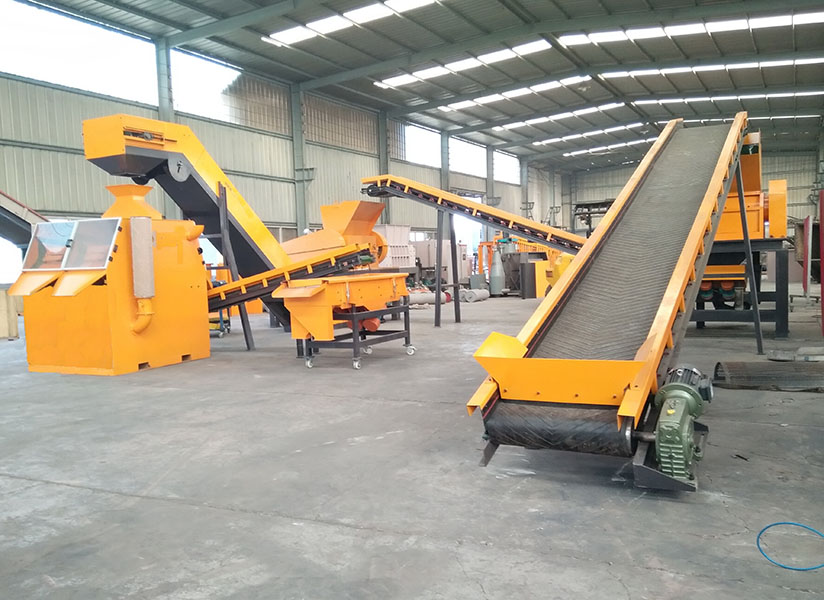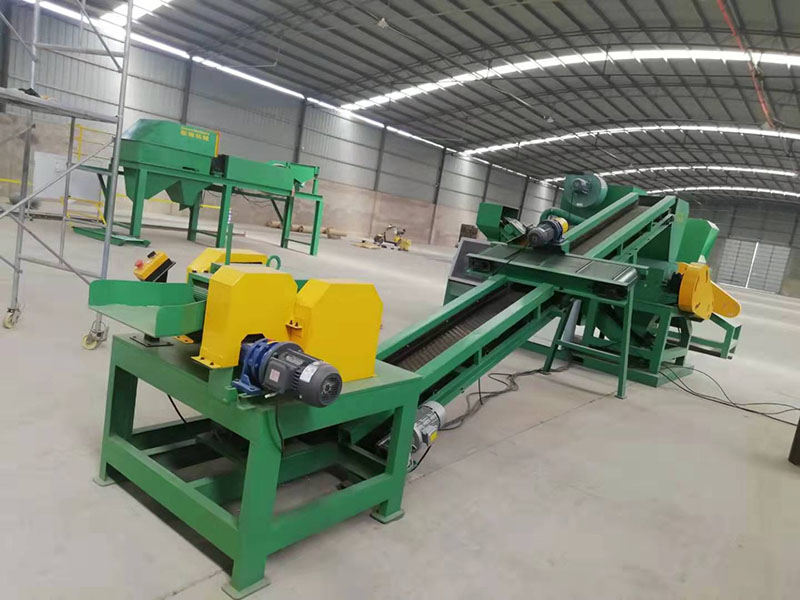
Sep . 20, 2025 22:05 Back to list
The escalating demand for raw materials and increasing environmental concerns have placed a significant emphasis on sustainable resource management. Copper, a vital metal in numerous industries, is a prime candidate for efficient recycling. The global copper recycling market is projected to grow significantly, driven by regulatory pressures, rising primary copper costs, and the economic benefits of recovering secondary raw materials. Technologies that facilitate this recovery are critical. One such innovation, central to modern scrap copper processing, is the Copper wire granulator. This advanced machinery plays a pivotal role in transforming scrap copper cables and wires into high-purity copper granules and plastic insulation, ready for re-entry into the manufacturing cycle. Its efficacy directly impacts cost savings, energy consumption, and environmental footprint across various industrial sectors.

Figure 1: High-efficiency granulation of scrap copper wires.
Industry trends indicate a continuous push towards higher purity output, greater automation, and improved energy efficiency in recycling equipment. Granulation technology is evolving to handle a wider variety of cable types, including fine wires and armored cables, with minimal material loss and maximum separation rates. This evolution underscores the importance of investing in robust, reliable, and technologically advanced granulation systems to meet current and future recycling demands.
The operation of a high-performance Copper wire granulator system involves a meticulously engineered multi-stage process designed to achieve optimal separation efficiency and material purity. The entire system is built with longevity and performance in mind, utilizing advanced manufacturing techniques and materials.

Figure 2: Precision cutting blades within the granulator.
These systems are indispensable across various sectors including:
Typical advantages in application scenarios include significant energy saving due to optimized motor-blade configurations and efficient separation, leading to reduced operational costs. The use of corrosion-resistant materials and robust construction ensures a long service life, even when processing varied scrap materials, minimizing downtime and maintenance requirements.
Selecting the appropriate Copper wire granulator requires a thorough understanding of its technical parameters and how they translate into operational efficiency and output quality. Expert design focuses on optimizing each stage of the granulation and separation process to handle diverse material inputs effectively.
| Parameter | Specification (OW-C600) |
|---|---|
| Processing Capacity | 300-500 kg/h (depending on material) |
| Motor Power (Granulator) | 37 kW |
| Total Power | 55 kW |
| Copper Purity (Output) | ≥ 99.5% |
| Blade Material | D2 (Cr12MoV) High-Alloy Tool Steel |
| Number of Granulator Blades (Rotary/Stationary) | 9 Rotary / 2 Stationary |
| Screen Mesh Size Options | 2mm, 3mm, 4mm, 5mm (customizable) |
| Dimensions (L×W×H) | ~5500×2000×3200 mm |
| Weight | ~4.5 tons |
| Noise Level | < 85 dB(A) |
The parameters above exemplify a balanced approach to capacity, efficiency, and operational stability. Blade materials like D2 tool steel are crucial for longevity, especially when processing varied cable types including armored or heavily insulated wires. The efficiency of the air and vibratory separation system is paramount; a well-designed system can achieve copper recovery rates upwards of 99%, minimizing valuable material loss. Expert insight into airflow dynamics (pneumatic classification) and vibratory table mechanics ensures that even fine copper particles are effectively segregated from non-metallic components.

Figure 3: Advanced control panel for optimized operation.
Furthermore, modern Copper wire granulator systems incorporate PLC (Programmable Logic Controller) based control panels, allowing for real-time monitoring of motor loads, automated feeding adjustments, and fault diagnostics. This level of automation not only enhances operational safety but also ensures consistent performance and reduces the need for constant manual intervention, reflecting a high degree of expertise in industrial machinery design.
The versatility and efficiency of the Copper wire granulator make it an invaluable asset across a spectrum of industrial applications where copper recovery is essential. Our experience with diverse clients highlights the adaptability and robust performance of these systems.
A major e-waste processor in North America reported a 25% increase in copper recovery efficiency after upgrading to our specialized granulator system, attributing this to the precision separation technology and robust design. "The reduction in operational downtime and the superior purity of the output copper have directly contributed to our profitability," states their operations manager. Another client, a medium-sized metal recycling yard, highlighted the system's ease of maintenance and energy efficiency. Their data indicated a 15% reduction in electricity consumption per ton of processed material compared to their previous shredding setup. These testimonials underscore the tangible benefits, including enhanced material recovery, reduced operational costs, and improved environmental compliance.

Figure 4: High-purity copper granules after processing.
Our service cases frequently involve tailoring systems for unique challenges, such as processing heavily armored telecommunication cables or very fine hair-like wires. Through iterative design and collaboration, we ensure that the implemented solution not only meets but often exceeds specific recovery targets and purity requirements, providing a reliable and profitable copper recycling operation.
The technical prowess of a leading Copper wire granulator system is reflected in its superior performance metrics and the authoritative endorsements it receives. Our commitment to engineering excellence ensures that our granulators offer distinct advantages, substantiated by rigorous testing and certifications.
Our Copper wire granulator systems adhere to international quality and safety standards, providing assurance of performance and reliability:
Through years of dedicated service and technological advancement, we have established ourselves as a trusted partner to numerous recycling enterprises globally, ranging from small local operations to large industrial conglomerates. Our commitment to data-driven performance and adherence to international standards solidify our position as an authoritative provider in the copper recycling machinery sector.
When investing in a Copper wire granulator, it is crucial to conduct a comprehensive vendor comparison. While many manufacturers offer granulators, key differentiators lie in performance consistency, build quality, after-sales support, and long-term operational costs. Below is a comparative overview, positioning OW Recycling against typical industry alternatives.
| Feature/Parameter | OW Recycling (e.g., OW-C600) | Competitor A (Mid-Tier) | Competitor B (Entry-Level) |
|---|---|---|---|
| Copper Purity Output | ≥ 99.5% (typically 99.8%) | 98-99% | 95-98% |
| Processing Capacity (kg/h) | 300-500 | 250-400 | 150-250 |
| Blade Material | D2 High-Alloy Tool Steel | 9CrSi or Cr12 | Standard Tool Steel |
| Energy Consumption (kW/ton) | ~100-120 kWh/ton | ~130-150 kWh/ton | ~160-200 kWh/ton |
| Dust Collection System | Integrated Pulse Bag Filter | Basic Cyclone Collector | Optional/None |
| Automation Level | PLC Control, Automated Feed | Basic Electrical Control | Manual Operation |
| Warranty (Years) | 1-2 Years (Parts & Labor) | 1 Year (Parts Only) | 6 Months (Limited) |
| After-Sales Support | Comprehensive: On-site, Remote, Parts Availability | Limited Remote, Basic Parts | Minimal/No Support |
As illustrated in the table, OW Recycling prioritizes high purity output, robust construction, and comprehensive support, leading to lower long-term operational costs and higher material value. While the initial investment might be higher than entry-level alternatives, the superior performance, extended service life, and reduced energy consumption of our Copper wire granulator systems deliver a significantly better return on investment over time. This comparison underscores the importance of evaluating not just the purchase price, but the total cost of ownership and the quality of the final product.
Recognizing that no two recycling operations are identical, OW Recycling specializes in providing customized Copper wire granulator solutions. Our engineering team works closely with clients to understand their unique material inputs, throughput requirements, facility constraints, and purity targets. This bespoke approach ensures maximum efficiency and ROI.
Customization options include:
Case Study 1: Large-Scale Automotive Wire Harness Recycling
A large automotive dismantling company required a solution to process over 10 tons of mixed vehicle wire harnesses per day. Their existing system struggled with variable material composition and fine wires, leading to significant copper loss. OW Recycling implemented a customized system featuring a heavy-duty pre-shredder, a high-capacity Copper wire granulator with specialized blades for fine wires, and a dual-stage air-vibratory separation unit. The solution increased copper recovery purity from 96% to 99.7% and boosted daily throughput by 40%, drastically improving their profit margins.
Case Study 2: Fine Copper Wire Recovery for Electronics Manufacturer
An electronics manufacturer faced challenges in recycling their internal production waste, which consisted of very fine (

Figure 5: Example of a modular granulator system designed for flexible deployment.
These cases demonstrate our capability to not just supply equipment, but to engineer comprehensive solutions that address specific operational challenges and deliver measurable improvements in efficiency and profitability for our clients.
Establishing trust with our B2B clients is paramount. This involves not only delivering high-performance machinery but also providing transparent information on critical aspects like lead times, warranty, and comprehensive after-sales support for every Copper wire granulator we supply.
Standard Copper wire granulator models typically have a lead time of 4-8 weeks from order confirmation to shipment, depending on current production schedules. Custom-engineered solutions or systems requiring extensive customization may have a lead time of 10-16 weeks. We provide detailed project timelines and maintain open communication throughout the manufacturing and delivery process. Factory acceptance tests (FAT) are standard for all equipment.
All OW Recycling copper wire granulators come with a comprehensive warranty of 1 to 2 years (depending on the specific model and components) covering manufacturing defects and critical parts. Extended warranty options are available. Our warranty terms are transparent, providing peace of mind regarding the longevity and reliability of your investment.
Our commitment extends beyond equipment delivery. We offer multi-faceted customer support:
The demand for efficient and environmentally sound copper recycling solutions continues to grow, making the Copper wire granulator an indispensable tool in modern resource recovery. From its precision engineering and robust construction to its high separation purity and energy efficiency, this technology offers a compelling value proposition for businesses in the recycling, manufacturing, and waste management sectors. OW Recycling is dedicated to providing advanced, reliable, and customized granulation systems that meet the evolving needs of the industry, contributing to both economic prosperity and environmental stewardship. By focusing on expertise, proven experience, authoritative certifications, and unwavering trustworthiness, we empower our clients to achieve superior copper recovery and operational excellence.
Latest news
Vertical Hammer Crusher: Efficiency and Sustainability in Modern Crushing
NewsNov.19,2025
Small Hammer Crushers: Compact Solutions for Efficient Material Processing
NewsNov.18,2025
Mobile Hammer Crusher – Versatile Crushing Solutions for Industry & Disaster Relief
NewsNov.18,2025
Hammer Mill Glass Crusher – Efficient Glass Recycling Solutions | OW Recycling
NewsNov.18,2025
Hammer Mill Car Shredder: Efficient Vehicle Recycling & Sustainable Waste Management
NewsNov.17,2025
Durable and Efficient Hammer for Crusher: Your Guide to Choosing the Best Impact Tools
NewsNov.15,2025